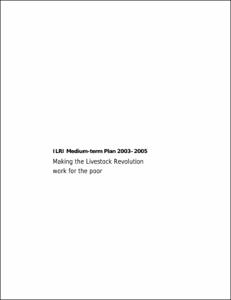ILRI annual report 2004: Achieving more with less: Livestock as a tool for agricultural intensification
ILRI medium-term plan 2003–2005: Making the livestock revolution work for the poor
Information support for sustainable soil fertility management (CTA seminar 2003): highlights
‘Poor soils make poor people, and poor people make soils worse’. This is a situation that can be seen in many ACP countries. What information support can be offered...
Knowledge to action: Tools for livestock development - ILRI annual report 2005
Methodological illustration of genotype x environment interaction (GxE) phenomenon and its implications: A comparative productivity performance study on Red Maasai and Dorper sheep breeds under contrasting environments in Kenya
Organic agriculture in Kenya and Uganda: study visit report
This report was produced following a study visit to Kenya and Uganda, 19–30 April 2004. The visit was sponsored by CTA and organised in collaboration with ORREDE and SACDEP–Kenya.
The changing face of pastoral systems in grass dominated ecosystems of Eastern Africa
All eastern Africa is in the tropics, but its grasslands cover a very wide range of altitudes. Extensive grasslands are mostly in arid and semi -arid zones. The area is subject to droughts and a high degree of pastoral risk.
The mountain grassland system offer an accumulative capacity of management
The mountain farmers operate on whole of animals (flocks, herds, working herds) copying models coming surely from the beginning of domestication. The apprenticeship lengthwise of centuries was received as a heritage and they will to enrich through every generational change.
Sustainable management of marginal drylands(SUMAMAD). Proceedings of the Third Project Workshop Djerba,Tunisia 11–15 December 2004
Millennium Development Goal Number Seven is particularly concerned with the safeguarding and provision of freshwater resources to all human.beings; this is a major challenge – and perhaps even the main challenge – for all the world’s drylands.
Livelihood mapping and poverty correlates at a meso-level in Kenya
Grassland of the world
This book brings together information on the contrasting characteristics, condition, present use and problems of the world's main natural grasslands. Since grassland is commercialized through the grazing animal, particular attention is paid to the livestock production systems associated with each main type.










